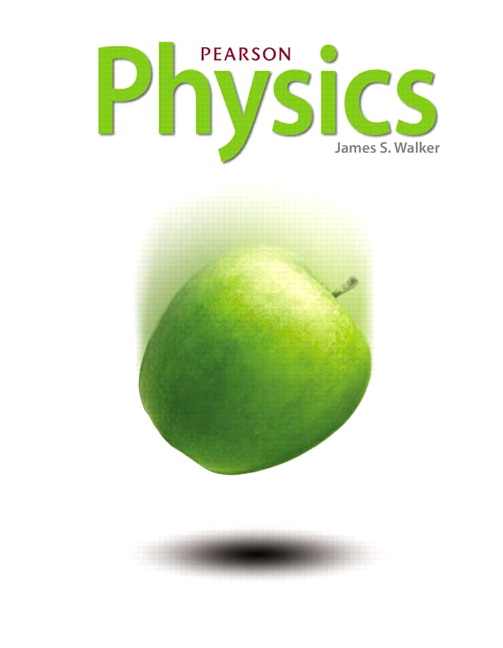
All Solutions
Page 595: Standardized Test Prep
tt{In the graph we plotted the image $d_i$ as a function of the object distance $d_o$, to determine the focal length of the mirror we will use the mirror equation that relates all of theses three variables:}
$$
$$
frac{1}{f}=frac{1}{d_o}+frac{1}{d_i}Rightarrow frac{1}{d_i}=frac{1}{f}-frac{1}{d_o}=frac{d_o-f}{d_of}
$$
$$
Rightarrow d_i=frac{d_of}{d_o-f}
$$
We can now determine the special value of $d_i$ when we put the object at the focal point of the mirror; in other words $d_olongrightarrow f$
$$
lim_{d_olongrightarrow f}{d_i}=lim_{d_olongrightarrow f}{frac{d_of}{d_o-f}}=infty
$$
We can see on the graph that the value of $d_i$ approaches infinity when $d_o$ is approaching 2.
$$
Rightarrow f=2
$$
tt{(B)}
$$
tt{The object is placed at 4cm, thefore $d_o=4cm$, based on the graph the image distance $d_i$ should be around +4cm, The image is real because $d_i>0$}
$$
tt{(A)}
$$
for the values of $d_o=2.5cm$ the values of the image distance $d_i$ is positive therefore the image is real.
tt{(D)}
$$
tt{The magnification equation states:}
$$
$$
m=frac{h_i}{h_o}=-frac{d_i}{d_o}
$$
In order for the image to be upright, the magnification factor need to be positive ($m>0$), The object is always infront of the mirror therfore $d_o$ is always postive, Consequencially the magnification factor sign depends from the image distance $d_i$ sign:
if $d_i0$
if $d_i>0Rightarrow m<0$
Based on the graph for the values of $d_o$=[2.5cm,3.5cm,4.5cm] The corresponding values of $d_i$ are positive therefore m is negative, Consequentially the image is inverted.
for $d_o$=1.5cm The corresponding value of $d_i$ is negative therefore m is positive, Consequentially the image is upright.
tt{(A)}
$$
tt{(B)}
$$
$$
f=-frac{R}{2}=-frac{20}{2}=-10cm
$$
To determine the type of image, we need to calculate the image distance to the mirror $d_i$:
$$
frac{1}{f}=frac{1}{d_o}+frac{1}{d_i}Rightarrow frac{1}{d_i}=frac{1}{f}-frac{1}{d_o}=frac{d_o-f}{d_of}
$$
$$
Rightarrow d_i=frac{d_of}{d_o-f}=frac{10*(-10)}{10+10}=-5cm
$$
$d_i0Rightarrow$ The image is upright.
$$
m=frac{h_i}{h_o}=frac{1}{2}Rightarrow h_i=frac{h_o}{2}
$$
$Rightarrow$ The image size is half the original size
tt{(C)}
$$
tt{An image former by a plane image is always located behind the mirror therefore it is virtual, it also concerves the dimensions of the real object and its orientation therfore $m=1$}
$$
tt{(c)}
$$
For the image location we will use the mirror equation as follows:
$$
frac{1}{f}=frac{1}{d_o}+frac{1}{d_i}Rightarrow frac{1}{d_i}=frac{1}{f}-frac{1}{d_o}=frac{d_o-f}{d_of}
$$
$$
Rightarrow d_i=frac{d_of}{d_o-f}=frac{3*6}{3-6}=boxed{-6cm}
$$
$d_i 0 Rightarrow$ The image is $text{color{#4257b2}{upright}}$ and $text{color{#4257b2}{twice}}$ as big.
tt{(A)}
$$
The experiment consists of converging the rays using a concave mirror, then determining the exact point $P$ where all the light converges then inserting a convex mirror in between. by moving the mirror left and right between the point $P$ and the other concave mirror, there will be a point in which the light will be reflected parallel to the mirror axis. In that exact location, we have to measure the distance between the convex mirror and the point $P$, this distance shall be the focal length $f$. Afterward, we can calculate the radius of curvature using the simple relation :
$$
f=-frac{R}{2}
$$
tt{Using converging rays we can determine the focal length}
$$
Haven't found what you were looking for?
Search for samples, answers to your questions and flashcards

